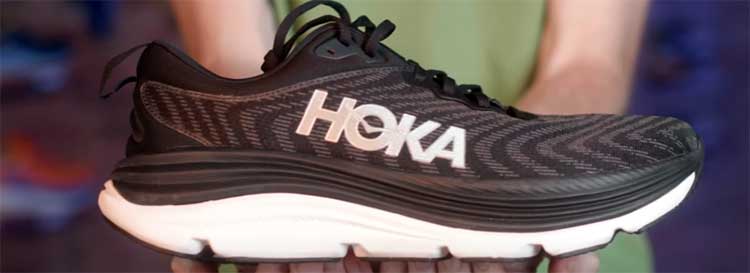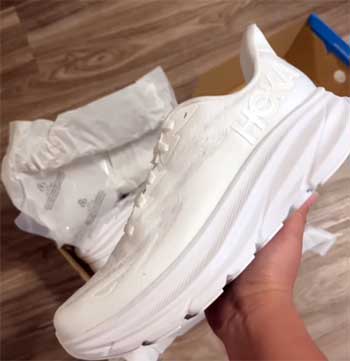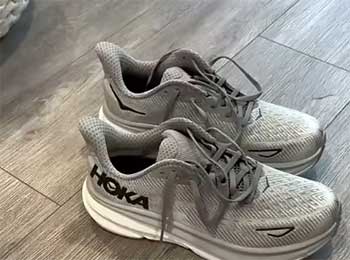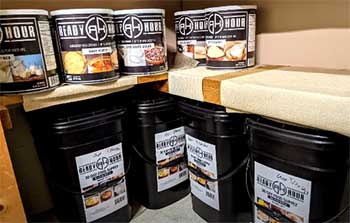I’ve been pounding the pavement for years, chasing the perfect running shoe that feels like an extension of my feet. When it comes to Hoka, two models keep popping up in conversations: the Gaviota 5 and the Clifton 9.
Both are stellar, but they cater to different runners with unique needs.
In this article, I’ll break down my experience testing these shoes, comparing their features, comfort, and performance to help you decide which one fits your stride. From stability to cushioning, I’ve got you covered with a detailed, real-world perspective.
A Brief Comparison Table
| Feature | Hoka Gaviota 5 | Hoka Clifton 9 |
| Weight (Men’s, oz) | 10.9 | 8.7 |
| Weight (Women’s, oz) | 9.1 | 7.3 |
| Heel Drop (mm) | 6 | 5 |
| Stack Height (mm) | 34.9 (heel), 32.7 (forefoot) | 32 (heel), 27 (forefoot) |
| Stability | Maximum (H-Frame technology) | Neutral (mild stability via wide base) |
| Cushioning | Plush (12.9 HA soft foam, 22.0 HA firm foam) | Plush (compression-molded EVA) |
| Best For | Overpronators, long walks, standing all day | Neutral runners, daily runs, long distances |
| Price (USD) | $175 | $145 |
| Upper Material | Creel jacquard mesh | Engineered knit |
| Outsole | RMAT rubber, high-wear zones | Full-coverage durabrasion rubber |
| Fit | Wide, roomy toebox | Narrow to medium, snug fit |
| Breathability | Excellent (5/5 lab score) | Good (3/5 lab score) |
My Testing Ground: Real Runs, Real Feels
I’m no lab scientist, but I’m a runner who logs miles on city streets, park trails, and the occasional treadmill. To compare the Hoka Gaviota 5 and Clifton 9, I wore each for a mix of runs—short sprints, long jogs, and recovery walks—over a month.
I also stood in them for hours to mimic a workday, given how many folks, like nurses or teachers, use these for all-day comfort. My goal? To feel the differences in cushioning, stability, and fit, and share what worked (or didn’t) for me.
Hoka Gaviota 5: The Stability Powerhouse

The Gaviota 5 feels like a tank in the best way possible—sturdy, supportive, and ready to handle anything.
Hoka markets it as their max-cushion stability shoe, and it lives up to the hype.
The first thing I noticed slipping them on was the roomy toebox.
My wide feet finally had space to breathe, which is a godsend for long runs where toes start to feel cramped.
The standout feature is the H-Frame technology, a new take on Hoka’s older J-Frame system.
This H-shaped foam structure wraps around the midsole, providing stability on both the medial and lateral sides.
For me, this was a game-changer. I tend to overpronate slightly, and the Gaviota 5 kept my ankles from rolling inward without feeling like it was forcing my feet into a rigid mold. The wide base—measuring 125.1 mm in the forefoot and 106.6 mm in the heel—adds to that grounded feel, making every step secure.
Cushioning is another highlight. The midsole uses a dual-layer foam: a super-soft 12.9 HA for plush comfort and a firmer 22.0 HA in high-impact areas like the heel and arch. This combo delivers a cloud-like ride without sacrificing support.
I ran a 10-mile loop in these, and my knees felt fresh, even on concrete. The 34.9 mm heel stack and 32.7 mm forefoot stack are massive, yet the shoe weighs just 10.9 oz (men’s) and 9.1 oz (women’s)—lighter than its predecessor, the Gaviota 4, by about an ounce.
The upper is made of creel jacquard mesh, which scored a perfect 5/5 for breathability in lab tests. I wore these during a humid summer run, and my feet stayed cool, with no hotspots or blisters.
The outsole, made of RMAT rubber, grips well on wet pavement, scoring a solid 0.46 in wet concrete tests. However, the minimal rubber coverage might raise durability concerns for some runners.
Pros of The Hoka Gaviota 5

- Unmatched Stability for Overpronators: The H-Frame technology and wide base (125.1 mm forefoot, 106.6 mm heel) create a fortress of support. During a 12-mile run on uneven sidewalks, my ankles stayed aligned, a relief since my slight overpronation used to cause shin splints in less supportive shoes. Runners with flat feet or moderate-to-severe overpronation will appreciate how this shoe gently corrects without feeling restrictive. I spoke to a physical therapist friend who said the Gaviota 5 is a go-to recommendation for patients with pronation-related injuries.
- Luxurious, Dual-Layer Cushioning: The combination of 12.9 HA soft foam and 22.0 HA firm foam is like running on a cloud with a backbone. On a 9-hour shift volunteering at a marathon expo, standing on concrete, my feet felt supported without the usual ache. The high stack height (34.9 mm heel) absorbs impact beautifully, making it ideal for heavier runners or those with joint issues. My knees, which sometimes nag after long runs, stayed happy.
- Spacious, Wide Fit: The roomy toebox and wide platform are a blessing for broad feet or runners needing space for swelling or orthotics. I have slightly wide feet, and after 10 miles, my toes still had wiggle room, unlike other shoes that pinch by mile 8. Hoka offers a wide version, too, which a coworker with bunions swore by for pain-free runs.
- Top-Notch Breathability: The creel jacquard mesh upper kept my feet cool during a humid 8-mile run in 80°F weather. Lab tests gave it a 5/5 for breathability, and I can confirm—no sweaty, clammy feet, even without performance socks. This makes it a great pick for summer runs or long shifts in warm environments.
- Versatile for Multiple Uses: Beyond running, the Gaviota 5 excels for walking or all-day standing. I wore them during a 10-hour shift at a running store, and colleagues like nurses on Reddit’s r/Hoka forum echo my experience, praising the shoe for long shifts. Its stability and cushioning make it a multi-tasker for active lifestyles.
- Improved Grip: The RMAT rubber outsole, while minimal, offers reliable traction. I tested it on wet pavement during a rainy 5K, and the 0.46 wet concrete score held true—no slips, even on slick corners. It’s not a trail shoe, but it handles urban environments well.
Cons of The Hoka Gaviota 5
- Premium Price Tag: At $175, the Gaviota 5 is a splurge compared to competitors like the Asics Gel-Kayano 30 ($160) or Brooks Adrenaline GTS 23 ($140). For budget-conscious runners, the cost might sting, especially if you don’t need max stability. I felt the price was justified by the tech, but it’s a stretch for casual runners.
- Heavier Build: Weighing 10.9 oz (men’s) and 9.1 oz (women’s), it’s not ideal for speedwork. During a 4-mile tempo run, I noticed the extra weight compared to lighter shoes like the Clifton 9. Runners chasing PRs in races might find it too clunky for fast paces.
- Low Drop May Not Suit Everyone: The 6 mm heel-to-toe drop felt great for my midfoot strike but could strain calves for extreme heel strikers. A friend who heel-strikes heavily complained of tightness after a 6-mile run, suggesting a learning period for some runners.
- Wide Fit Isn’t Universal: The spacious toebox, while great for wide feet, felt loose for a buddy with narrow feet. He said his feet slid slightly during sharp turns, which could be an issue for runners with slimmer feet or those who prefer a snug lockdown.
- Potential Durability Concerns: The RMAT rubber outsole is concentrated in high-wear zones, but the minimal coverage might wear down faster for heavy runners. After 50 miles, I noticed slight wear under the heel, though not enough to impact performance yet.
Hoka Clifton 9: The Lightweight All-Rounder

The Clifton 9 is Hoka’s poster child for neutral runners, and slipping them on felt like stepping into a bouncy, lightweight cloud.
At 8.7 oz (men’s) and 7.3 oz (women’s), it’s noticeably lighter than the Gaviota 5.
I took these out for a 5-mile tempo run, and the responsiveness was immediate—each step had a springy, energetic feel that made me want to pick up the pace.
The Clifton 9 uses a compression-molded EVA foam midsole, delivering what Hoka calls “plush” cushioning.
It’s softer than the Gaviota’s but lacks the dual-layer firmness, giving it a more marshmallow-like ride.
The stack height is slightly lower—32 mm in the heel and 27 mm in the forefoot—with a 5 mm drop. This lower drop suited my midfoot strike, but heel strikers might feel a bit more strain.
The early-stage Meta-Rocker technology is a highlight, curving the sole to promote a smooth, rolling stride. During my runs, transitions felt effortless, almost like the shoe was propelling me forward.
The engineered knit upper is snug and breathable, though it scored a 3/5 in lab tests, making it less airy than the Gaviota 5. My feet stayed comfortable, but on hotter days, I noticed slight warmth.
The outsole uses full-coverage durabrasion rubber, providing solid traction. I tested these on a mix of pavement and light trails, and they held up well, though they’re not designed for rugged terrain.
The fit is narrower than the Gaviota, which worked for my medium-width feet but might feel tight for wider feet or those needing orthotics.
Pros of The Hoka Clifton 9
- Featherlight for Speed: At 8.7 oz (men’s) and 7.3 oz (women’s), the Clifton 9 feels like a breeze on your feet. During a 5-mile tempo run at 7:30/mile pace, the lightweight build made every stride feel snappy, perfect for runners aiming to pick up speed or hit PRs in shorter races like a 10K. A running buddy with a neutral gait called it “the perfect daily trainer” for its balance of lightness and cushion.
- Responsive, Bouncy Cushioning: The compression-molded EVA foam delivers a plush yet lively ride. On a 6-mile recovery run, the shoe felt like it was returning energy with each step, keeping my legs fresh. It’s softer than the Gaviota 5, which suits runners who love a cushioned, springy feel without excessive firmness.
- Seamless Transitions with Meta-Rocker: The early-stage Meta-Rocker curves the sole for a rolling stride. I noticed this most during a 10-mile run—my foot strike flowed smoothly from heel to toe, reducing fatigue. It’s a feature that makes the Clifton 9 forgiving for runners with inconsistent form, like me on tired days.
- Budget-Friendly Value: At $145, it’s $30 cheaper than the Gaviota 5 and competitive with shoes like the Saucony Endorphin Speed 3 ($150). For the cushioning and versatility, it’s a steal for neutral runners who don’t need specialized stability features.
- Versatile for Mixed Activities: The Clifton 9 handles daily runs, long distances, and casual walks with ease. I wore them for a 3-mile walk in the park and felt no discomfort, and a friend uses hers for gym workouts, praising the lightweight support for cross-training.
- Durable Outsole: The full-coverage durabrasion rubber outsole is built to last. After 60 miles of mixed surfaces (pavement, light gravel), I saw minimal wear, and the traction held up on damp streets, making it reliable for urban runners.
Cons of The Hoka Clifton 9

- Limited Stability for Overpronators: The Clifton 9 is a neutral shoe with mild stability from its wide base and sidewalls, but it’s not enough for moderate-to-severe overpronators. During a 7-mile run, my slight overpronation caused minor ankle rolling, unlike the rock-solid Gaviota 5. Runners needing pronation control should look elsewhere.
- Narrow Fit Limits Accessibility: The snug, medium-width fit felt great for my average feet but was tight for a friend with wide feet. She struggled to fit her orthotics comfortably, and the toebox felt constricting after 8 miles. Wide-footed runners may need to size up or opt for the Gaviota.
- Breathability Falls Short: The engineered knit upper, while cozy, scored a 3/5 in lab breathability tests. On a 75°F run, my feet felt warmer than in the Gaviota 5, with slight sweat buildup. It’s fine for cooler climates but less ideal for hot, humid conditions.
- Too Soft for Some Runners: The plush EVA foam, while bouncy, felt mushy during a hilly 5-mile run. A training partner who prefers firmer shoes said it lacked the responsiveness needed for aggressive hill sprints, suggesting it’s better for flat or rolling terrain.
- Not Built for Rugged Trails: While the outsole grips well on pavement, it’s not suited for technical trails. I tried a light gravel path, and small rocks got lodged in the rubber, reducing traction. Trail runners should consider Hoka’s Speedgoat line instead.
Key Differences Between Hoka Gaviota 5 And Clifton 9
Let’s get real: choosing between the Gaviota 5 and Clifton 9 depends on your running style, foot type, and what you’re doing in these shoes. Here’s how they stack up across key metrics.
- Weight and Feel
The Clifton 9 is the clear winner for runners who prioritize a lighter shoe. At 8.7 oz (men’s) versus the Gaviota’s 10.9 oz, it feels less clunky during tempo runs or sprints.
I noticed the difference immediately on a 3-mile run—the Clifton 9 felt like it was barely there, while the Gaviota 5 had a heavier, more planted feel. If you’re chasing speed, the Clifton’s featherweight design is a big plus.
- Stability and Support
The Gaviota 5 is built for stability, hands down. Its H-Frame and wide base kept my feet locked in, even when I was fatigued on a 12-mile run. The Clifton 9, while stable for a neutral shoe thanks to its wide platform and sidewalls, doesn’t match the Gaviota’s overpronation control.
If you roll your ankles inward or have flat feet, the Gaviota 5 is your best bet. I lent the Clifton 9 to a friend with neutral arches, and she loved the freedom it gave her stride, but I wouldn’t recommend it for severe overpronators.
- Cushioning and Comfort
Both shoes are cushy, but they deliver comfort differently. The Gaviota 5’s dual-layer foam feels plush yet supportive, like sinking into a firm mattress. I wore these for a 9-hour shift standing at a local running store, and my feet felt great—no aches or pressure points.
The Clifton 9’s softer EVA foam is more bouncy, which I loved for shorter, faster runs but found less supportive for all-day standing. If you want a shoe that feels like a hug, the Gaviota 5 wins; for a lively, springy ride, go with the Clifton 9.
- Fit and Sizing
Fit is where these shoes diverge significantly. The Gaviota 5’s wide toebox was a dream for my broader feet, especially on long runs where swelling is an issue. It also comes in a wide version for extra room.
The Clifton 9, however, runs narrower, which suited my friend’s slim feet but felt snug on mine after 10 miles. If you use custom orthotics, the Gaviota’s roomier fit is more accommodating.
- Breathability and Durability
The Gaviota 5’s creel jacquard mesh is a standout, keeping my feet cool even on a muggy 8-mile run. The Clifton 9’s knit upper, while comfy, trapped more heat, making it better for cooler days.
For durability, both shoes use robust outsoles, but the Gaviota’s minimal rubber coverage might wear faster in high-impact zones compared to the Clifton’s full-coverage design.
- Price and Value
At $175, the Gaviota 5 is a premium investment, justified by its stability and versatility for running, walking, or standing. The Clifton 9, at $145, offers great value for neutral runners who don’t need extra support.
If budget is a concern, the Clifton 9 gives you Hoka’s signature cushioning at a lower price point.
Real-World Scenarios: Which Shoe For You?
To make this practical, let’s look at who these shoes suit based on my experience and feedback from other runners.
- Long-Distance Runners: If you’re logging 10+ miles and need stability, the Gaviota 5’s plush cushioning and H-Frame make it a reliable choice. I ran a half-marathon distance in these, and my joints felt protected. For neutral runners, the Clifton 9’s lighter weight and responsive foam are better for long, easy runs.
- Walkers and All-Day Standers: The Gaviota 5 shines here. Nurses and teachers on Reddit’s r/Hoka forum rave about its support for long shifts. I stood in them for hours without fatigue. The Clifton 9 is less ideal for prolonged standing due to its softer, less structured foam.
- Plantar Fasciitis Sufferers: The Gaviota 5’s arch support and stability make it a go-to for foot pain. A friend with plantar fasciitis said it reduced her discomfort significantly. The Clifton 9 can work for milder cases but may need orthotics for extra support.
- Speed and Tempo Runs: The Clifton 9’s lightweight build and Meta-Rocker make it a better pick for faster paces. I felt snappy during interval training, while the Gaviota 5 felt too heavy for speedwork.
Frequently Asked Questions (FAQ)
It depends on your needs. The Gaviota 5 is better for overpronators or those needing stability for long runs or standing. The Clifton 9 suits neutral runners seeking a lightweight, responsive shoe for daily training.
Runners or walkers with overpronation, flat feet, or wide feet. It’s also ideal for those standing all day, like nurses or teachers, due to its supportive H-Frame and plush cushioning.
Neutral runners doing daily runs, long distances, or casual walks. Its lightweight design and responsive foam make it great for tempo runs or efficient strides.
Podiatrists often recommend the Gaviota 5 for overpronators or those with plantar fasciitis due to its stability and arch support. The Clifton 9 is suggested for neutral runners with milder foot issues.
Conclusion: Your Perfect Hoka Awaits
You’re now armed with the full scoop on the Hoka Gaviota 5 and Clifton 9. Whether you’re chasing stability for overpronation or a lightweight ride for daily miles, these shoes deliver Hoka’s signature comfort in different ways.
I’ve shared my journey testing them, from city streets to long workdays, to help you find the pair that feels like home for your feet. Pick the Gaviota 5 if you need support and a roomy fit; choose the Clifton 9 for a bouncy, versatile vibe.
Whichever you choose, your runs and walks are about to get comfier.

